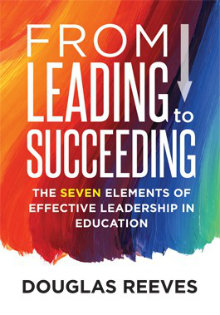7 Elements of Effective Leadership in Education
From Leading to Succeeding: The Seven Elements of Effective Leadership in Education
By Douglas Reeves
(Solution Tree Press, 2016 – Learn more)

Vision without implementation is counterproductive.
~Douglas Reeves
In From Leading to Succeeding, change leader Douglas Reeves discusses what he believes are the seven elements of effective leadership. He notes that he was inspired by the classic, The Elements of Style, by William Strunk Jr. written in 1918.
Strunk’s book served as a guide for writers, and he suggests that his own book can be thought of as a guide for leaders in a very similar way. Reeves writes, “The world does not need another book telling leaders what to do. What it needs is clear and specific guidance on how to tell the difference between” what works in leadership and what doesn’t. Lofty goal for a book.

Reeves also suggests that the book is less meant to be read cover-to-cover and more to be parsed out in small chunks with ample time for reflection and even to be used “as grist for study and discussion in a leadership meeting” or other professional learning community (p. 2).
The majority of the book is given over to individual chapters discussing each element in turn. What stands out in each is Reeves’ attention not only to what the element is but also what it is not. That is to say, he believes that counter examples are as instructive as positive one and uses them liberally. Below is a brief summary of each chapter.
Purpose: Here Reeves looks at mission and vision statements and asks leaders to think deeply about what the purpose of the school is. He maintains that unless leaders can quickly and succinctly state their purpose, it will be hard to attain and/or maintain success. Further, leaders must feel passion for the purpose and work to spread that purpose like wildfire. The counterexample here comes from what Reeves thinks of as the wordy yet hollow mission statements on the banners of most school websites.
Trust: Leaders must say what they mean, mean what they say, and follow through with promises. Reeves explains that once trust is broken, leadership for sustained and positive change becomes nearly impossible. Similarly, to develop trust, leaders must do some things which may seem counter-intuitive. They must, for example, admit to and apologize for mistakes and be willing to respectfully and kindly confront personnel to discuss needed changes.
Focus: Schools that are successful know their vision, align it to goals, and only think about, talk about, and act on work that is focused on meeting those goals. Reeves reminds leaders to “weed your education garden” (p. 47), a powerful metaphor for keeping priorities aligned and not getting caught up in shiny new programs or tools that might take our eyes off the goal.
Leverage: This element is concerned with how and why to choose strategies that focus work in the way that will be most impactful. Reeves says that quite often the why is clear, but the how is somewhat less so. Figuring out what strategy is the best for meeting goals depends on watchfulness and a willingness to read school results data objectively.
Feedback: Leaders who succeed use feedback that is FAST: fair, accurate, specific, and timely (p. 75). Reeves argues that feedback is an essential part of a leader’s work and that it must be prompt, instructionally focused, and ongoing.
Change: Here Reeves examines the idea that leaders must be willing to embrace change even though it can be hard, messy, and sometimes scary. He says that change in organizations is essential but that it must be focused change, guided by purpose and designed to enhance trust.
Sustainability: This last element examines the need for capacity building such that change sticks even as leaders come and go. Reeves wraps this element back to the other six in that change that is sustainable is change that is built on purpose, trust, focus, strong leverage points, and continuing feedback patterns.
Above, I suggested that Reeves’ goal for this book was lofty. Indeed, after reading it, I feel no closer to clarity on how these elements could or should play out in struggling schools all over America. But, then again, I read it exactly as Reeves said not to, cover-to-cover.
It was compelling enough to keep me turning pages. This year, I am going to consult it as Reeves suggested, over time. I will study it, use it as grist for my thought mill, and as fuel for discussions among my PLN (personal learning network) colleagues.
Reeves writes, “There is no formula to protect you from frustration, exhaustion, and occasional fits of despair…the antidote [however] is hope” (p.10). In that spirit, it is my hope that this book will be increasingly significant over time.
Rita Platt (@ritaplatt) is a National Board Certified teacher with master’s degrees in reading, library, and leadership. Her experience includes teaching learners in remote Alaskan villages, inner cities, and rural communities. She currently is a teacher-librarian, teaches graduate courses for the Professional Development Institute and writes for We Teach We Learn.



































I hope any leadership training emphasises the mission statement. My experience is “You must write one” but then no one really explains why in operational terms. The best example I have come across is “If what you are thinking of doing supports your mission statement then do it. If not don’t do it!” Here is my reflections on leadership and my suggestions using my acronym Leaders “ENABLE”. http://wp.me/p2LphS-rN
Purpose and trust especially have to be the same between upper management, principals and teachers. If upper management is out of sync with principals, for example, principals cannot lead, but become managers of the status quo despite their own personal vision and desire to make a real difference.